Telescope Review
Sky-Watcher BKP150 DS Newtonian
Purchase price: JPY 32,000 (OTA plus α, stock clearance sale)
Dealer: KYOEI, Tokyo, Japan
Conclusion: Well suited for both deepsky and lunar/planetary imaging.
Please appreciate that this review reflects personal impressions and views.
The Sky-Watcher BKP150 DS is a Newtonian reflector constructed with a black aluminum tube (OTA 690 mm long, ≅6 kgs including two tube rings and finder), with a multi-coated aluminized 150 mm "diffraction limited" parabolic mirror of 750 mm focal length (F5), developed by Synta/Sky-Watcher/Pacific Telescope Corp. and fabricated by Suzhou Synta Optical Technology Co., Ltd. in the PR of China. Particularly appealing is its 2-inch dual-speed 10:1 crayford focuser for accurate, less painful focusing and its secondary mirror (Ø47 mm = 14.5% by area) positioned closer to the primary mirror to optimize prime-focus photography. The back focus is 86 mm, the focuser travel is 36 mm. 'P' in BKP stands for "Photo". Though not expressly specified a such, this Newtonian resembles an Astrograph.
The box includes a 2-inch 52° 28 mm 3-element (modified) Kellner eyepiece, a 6x30 finder scope plus all parts required to connect either a DSLR camera or for use with 2"/1.25" eyepieces. A DSLR will get into focus with the bundled adapters and a Ø42 mm T-ring. As a nice gesture a spanner and Phillips screw driver are also included, though a 2 mm Allen key for collimation was not in the box (1$-shop, problem solved).
Out of the Box
Though the secondary mirror was slightly off, the first impression was highly positive. A solid tube and a rigid, smooth dual-speed focuser. The bundled 28 mm Kellner eyepiece delivers clear views, however, the secondary mirror shadow is projected in the center, faint but notable on bright objects. No big issue, but it tells that eyepieces longer than 20 mm are not really useful. A 20 mm 1.25" Plössl eyepiece and shorter do not show the central shadow.
Sliding the Focuser
The Crayford focuser is very smooth throughout its travel and the fine 10:1 adjustment is a great touch and it is not wacky. Made of shining aluminum, the focuser tube could cause internal reflections. Likewise, the secondary mirror has shiny glass edges. Image quality could benefit from blackening shiny parts inside the tube.
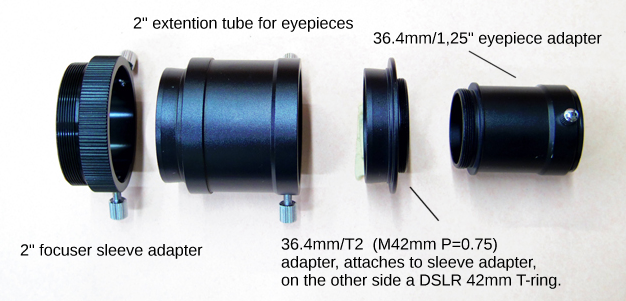 Bundled adapters for visual and imaging with DSLR or dedicated CMOS camera.
Bundled adapters for visual and imaging with DSLR or dedicated CMOS camera.
Bundled Eyepiece
Surprisingly, the low-cost eyepiece is not bad at all and a welcome gesture. Stars look crisp in the center region and a bit stretched outwards which is due to reflector-inherent coma. With an apparent FOV of 52° it is not exactly a 'wide' eyepiece, but with its 2-inch barrel diameter the FOV is 'comfortably wide' (probably subjective). Its simple Kellner design with only three elements does have the advantage of less air-to-glass interfaces.
Typically there are two reasons to go with 2" eyepieces. First, to get a wider field of view (FOV). Second, to impress your friends. The widest field eyepiece possible with a 1.25" barrel is 24 mm with an apparent field of view (AFOV) of 68°. For wider views, you must use a 2" diagonal and eyepiece. A 2" barrel eyepiece with say, 72° AFOV can be fully used in a 2" sleeve only. The AFOV would shrink to about 58° in a 1.25" sleeve.
Connecting Imagers
Laudably, this Newtonian has been designed with imaging in mind. Its backfocus is 86mm. A DSLR reaches prime focus without optional parts, however no means of integrating a 2-inch filter. Naturally, extensions are required for working with barlows. The lens part of a 2-inch, 2x barlow screwed into a T-ring requires a 2-inch extension with 30 to 50 mm optical path with which focuser travel can be kept short alongside the advantage of having a 2-inch filter thread. So sandwiched, the focal length increases to FL=1250 mm (FR=8.3). A CMOS camera with a 1.25" nose adapter reaches focus with or without a 2x barlow. The bundled 47 mm long 2-inch extension tube is threaded for Ø48 mm filters and dimensioned for bringing eyepieces into focus. It can of course be universally used for other telescopes with 2-inch focuser sleeves.
With this being confirmed, this Newtonian is nearly perfect for various deepsky and planetary imaging tasks.
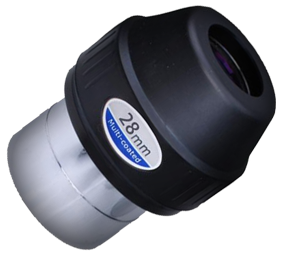 Bundled 2-inch 28 mm eyepiece with an 52° FOV performs better than expected and is also useful for centering targets for cameras with small sensors.
Bundled 2-inch 28 mm eyepiece with an 52° FOV performs better than expected and is also useful for centering targets for cameras with small sensors.
Sample Images
Deepsky
Before imaging with a Newtonian it is a good idea to check collimation (adjustment of optical axis) and correct if need be as accurate collimation is essential for good images. The quality of deepsky images in terms of aberration and coma depends on the optics (often also on tilt in the optical train, collimation and back focus issues) while atmospheric seeing and the camera sensor plus integration time are the main factors influencing image noise and dynamic range. Another critical factor is skill and experience in both image acquisition and processing.
BKP150, Nikon D5500, no filter, 70 x 30 seconds each at ISO400, FOV = 1.35 x 0.76°
BKP150, Nikon D5300, no filter, 38 x 120 seconds each at ISO1600, FOV = 1.68 x 0.94°
BKP150, Nikon D5500, no filter, 100 x 60 seconds each at ISO1600, FOV = 1.74 x 0.98°
The Moon in Color
With its 6 inches aperture the BKP150 is ideal for the first steps into lunar surface photography. Given the short native focal length of 750mm, a 2x barlow (a 3x barlow when seeing is excellent) is essential for lunar surface imaging. All sample images are 1.5x drizzled. Further images in the Gallery.
BKP150, ASI462MC, IR-Cut filter, 2x barlow, 2.5ms at gain 200, 138fps, 600 frames, FOV = 12.95 x 7.28'
BKP150, ASI462MC, IR-Cut filter, 2x barlow, 3ms at gain 200, 138fps, 400 frames, FOV = 13.56 x 7.12'
BKP150, ASI462MC, IR-Cut filter, 2x barlow, 5ms at gain 200, 138fps, 600 frames, FOV = 12.75 x 7.12'
The Moon in Monochrome
All sample images are 1.5x drizzled. Further images in the Gallery.
BKP150, ASI290MC, IR742nm filter, 2x barlow, 10ms at gain 200, 100fps, 600 frames, FOV = 12.84 x 7.30'
BKP150, ASI290MC, IR640nm filter, 2x barlow, 4ms at gain 200, 170fps, 600 frames, FOV = 13.03 x 7.34'
BKP150, ASI290MC, IR742nm filter, no barlow, 4ms at gain 120, 170fps, 200 frames, 4-pane mosaic, FOV = 32.78 x 22.25'
Planets
Given the short native focal length of 750mm, a 3x barlow is essential for planetary imaging. Image properties annotated on images.
Optimize Images
A Newtonian is free of chromatic aberration as light is reflected, not refracted. It produces diffraction spikes around bright stars which are not astronomical but beautiful. The only concern may raise about fast-reflector-inherent coma at the edges of the view. However, if you use a DSLR with a crop sensor the worst of the coma will be off of the edges in that a coma corrector may not be worth spending a little fortune for. You may as well wish to crop a, say, 6000x4000 pixels image by 20% to 30% thus cutting off comatic (elngated) stars.
However, if coma and its removal by image cropping is not your preference, an optional coma corrector will do the trick. Sky-Watcher offers a dedicated corrector threaded for Ø48 mm T-rings for its fast F5 Newtonians, while Baader Planetarium offers its own version compatible with F4/F5/F6 focal ratios, threaded for both, Ø42 mm and Ø48 mm T-rings. Note that coma correctors typically require 55 mm distance to the image sensor in order to work as advertised. Since the flange back of CMOS cameras are short (7.5 to 12.5 mm) an extension tube between the coma corrector thread and the camera thread is required. A coma corrector is usually directly plugged into the 2" eyepiece sleeve of the BKP150.
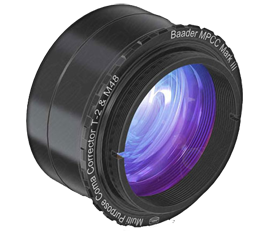 ▲ Example: Baader Planetarium's coma corrector.
▲ Example: Baader Planetarium's coma corrector.
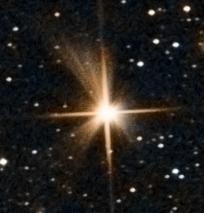
Helix-shaped reflections that form on stars other than diffraction spikes are commonly found with newtonian reflectors. The issue can be reduced or eliminated by attaching an aperture mask entirely covering the brackets (clips) that hold the outer edge of the primary mirror. It should be preinstalled by the telescope manufacturer. The only minor drawback is loss of mirror area, reducing the effective focal ratio by a practically unnoticeable amount.
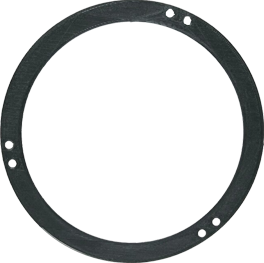 ▲ Example: Aperture mask for Newtonians.
▲ Example: Aperture mask for Newtonians.
The Choice of Tube Size
If less burden on your mount and higher portability is desirable, consider the same but smaller version OTA, the BKP130 with FL=650 mm and a Ø130 mm F5 mirror which weighs under 4kg. Reviews in astronomy forums confirm that the photographic image quality rivals that of the 150 mm Newtonian, but is only about 50 USD less. The 200 mm tube is about the maximum payload for an Orion Atlas EQ-G mount. The following table has all parameters at a glance.
Sky-Watcher BKP Newtonians
| Model | Aperture | Focal Length | F-number | Weight | Tube Length | FOV (*1) | Res (*2) |
|---|---|---|---|---|---|---|---|
| BKP 130 DS | 130mm | 650mm | F5.0 | 4kg | 615mm | 2.07° | 1.24" |
| BKP 150 DS | 150mm | 750mm | F5.0 | 6kg | 690mm | 1.80° | 1.08" |
| BKP 200 DS | 200mm | 1000mm | F5.0 | 9kg | 920mm | 1.35° | 0.81" |
| BKP 250 DS | 250mm | 1200mm | F4.8 | 15kg | 1120mm | 1.12° | 0.67" |
| BKP 300 DS | 300mm | 1500mm | F5.0 | 18kg | 1450mm | 0.90° | 0.54" |
(*2) Res: is the pixel resolution (image scale) in arc seconds per pixel based on an DSLR image sensor with 3.92µum pixels (ideal is 0.67" to 2").
Reference: http://skywatcher.com/series/astrophotography-reflectors/
The data showcases that only the 130/150 models are useful for wide field deepsky imaging. The larger models have narrower fields, a larger weight and a longer tube. The big payloads burden a mount and limit portability, while all are fast F5 Newtonians equally minimizing exposure times, just on wide or narrow fields, the latter demanding higher tracking/guiding accuracy but in turn catch more details of smaller and fainter objects with precise tracking. All models can use the same coma correctors, say, the Sky-Watcher F5 corrector or the Baader MPCC Mark III F4-F6 corrector. Each Newtonian size represents a compromise.
Pros
- Convincing optical performance for both, visual and photographic use.
- Coma-free image circle large enough for planetary CMOS cameras.
- Stunning views of nebulae and star clusters under a dark sky.
- Rigid, smooth dual-fit 1.25"/2", 10:1 focuser with lock screw.
- Thin spider vanes, donut ring on primary mirror to aid collimation.
- Both tube rings threaded for accessories.
- Bundled 2" Kellner eyepiece performs better than expected.
- Bundles all adapters required for imaging and visual use.
Cons
- Silver shiny surfaces inside the tube (focuser).
- Needs a costly coma corrector for serious deepsky imaging.
- Extensions sleeves use screws instead of modern clamp rings.
Recommendation
- The 6x30 finder scope could be replaced with a simple red dot finder, also for saving a bit weight.
- Preinstallation of an aperture mask. Blacken all silver surfaces.
Verdict
The fast optics and mirror positioning render this scope an astrograph, but it can as well be used for visual observation (to impress your friends). A coma corrector will provide a flattened field with sharp round stars in the image edges. This telescope is a regret-free purchase.
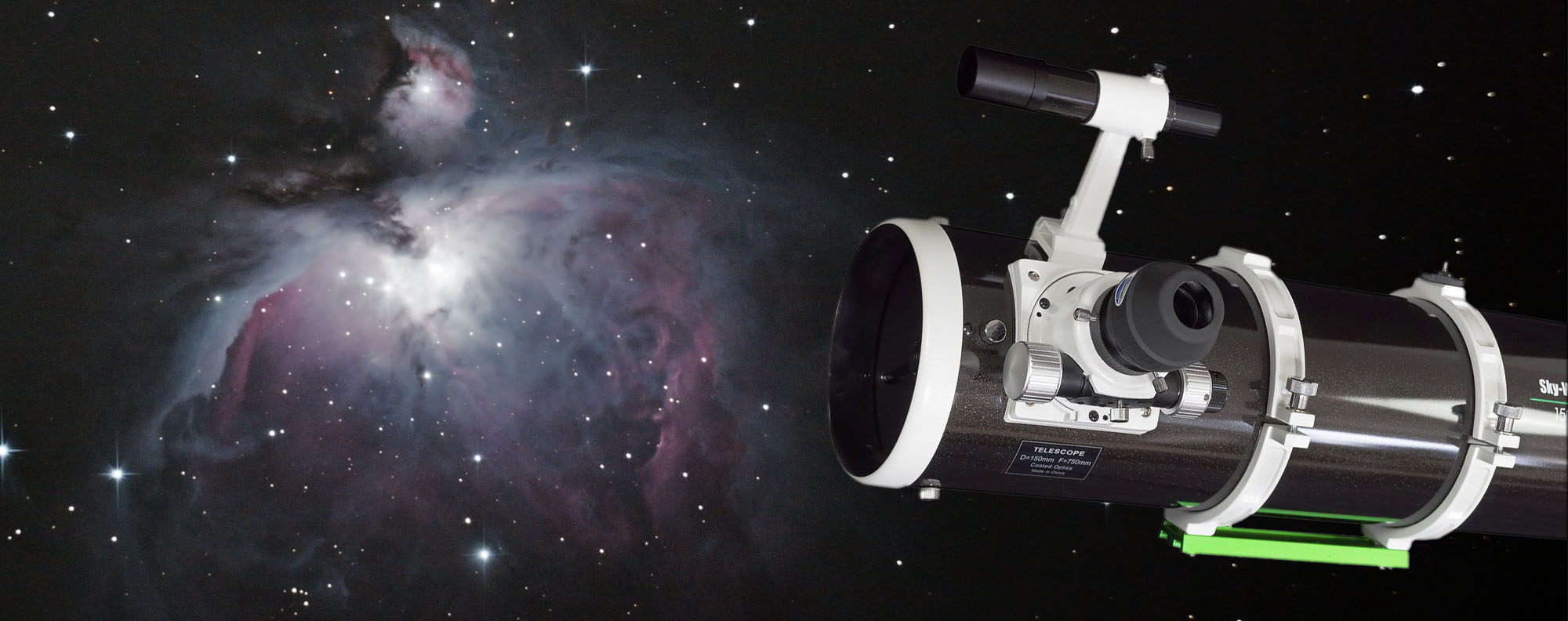












 The BKP150 OTAW seated on an Orion Atlas EQ-G mount with a piggybacked
The BKP150 OTAW seated on an Orion Atlas EQ-G mount with a piggybacked 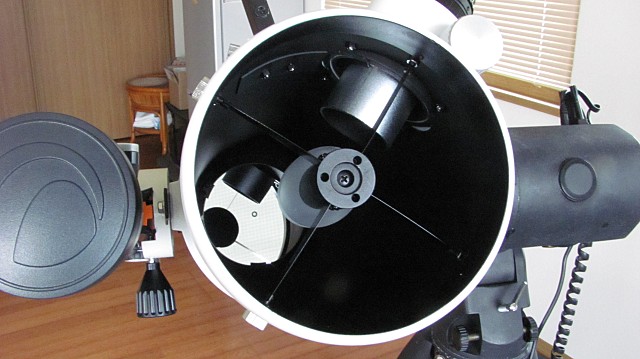 Extra thin spider vanes and a "donut" ring on the primary mirror center to ease collimation. The silver-shining focuser tube can cause unwanted reflections.
Extra thin spider vanes and a "donut" ring on the primary mirror center to ease collimation. The silver-shining focuser tube can cause unwanted reflections.
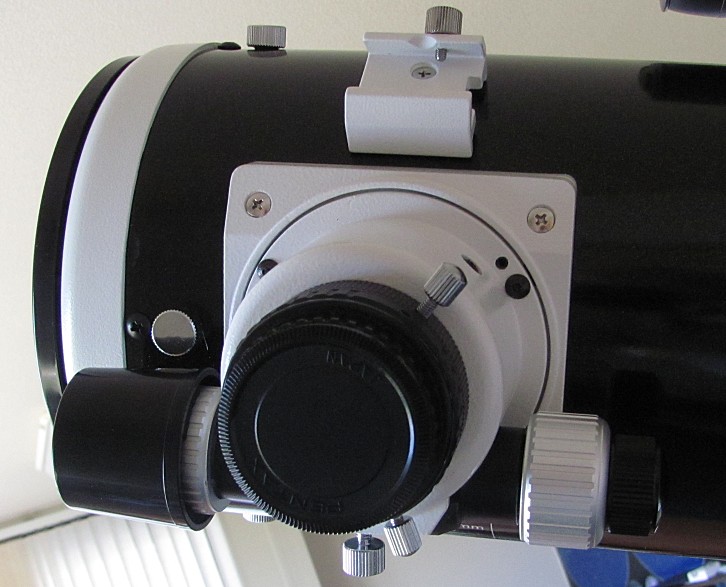 Solid and smooth dual-speed Crayford focuser.
Solid and smooth dual-speed Crayford focuser.
